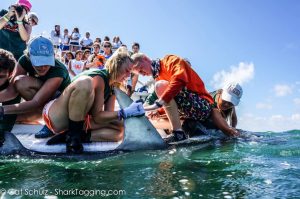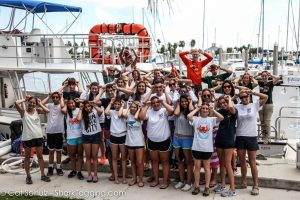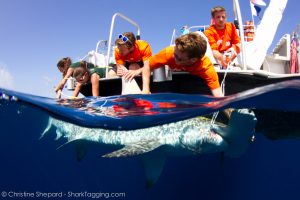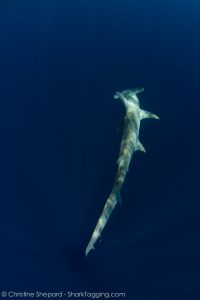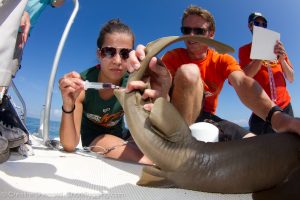Shark Tagging with St. Thomas Aquinas
By Emily Rose Nelson, RJD Intern
After collecting gear from RSMAS I met up with the rest of the team at the dock of divers paradise. We had a great crew on board and everyone was excited to get out there. Our guests for the day, the marine biology club from St. Thomas Aquinas High School, made their way on board, and after introductions we were off.
We were fishing in the Key Biscayne Safety Valve right near Stiltsville. RJD had been to this sight a few times in the days before and had great luck so I was feeling optimistic. As I was pulling in a line toward the end of the first set I felt a little tug but not much; I assumed it was just a big piece of bait. As I continued to pull the line up I felt a number of tiny tugs, but still just passed it off as a big chunk of barracuda. After I had almost the whole line in I realized it indeed not just bait on the end of the line but an Atlantic Sharpnose. These sharks are one of the smaller species we catch, rarely reaching a total length much greater than 1 meter. Our team brought the shark on board for a quick work up. The students from St. Thomas Aquinas did a great job assisting in the process and the shark was back in the water in no time.
Not shortly after, as we were approaching one of our drumlines Captain Eric called down to the deck “shark on.” From up top he could see the beautiful Great Hammerhead we had on this line before we even started to pull it in. Knowing that hammerheads are especially vulnerable to capture stress I pulled the line in swiftly. We assessed the condition of the shark and after confirming it was doing well the team restrained it along the side of the boat. We attached a satellite tag to the animal and released it as quickly as possible. The shark swam away with no sign of stress, kicking hard back on its way. I am excited to watch where this beautiful shark travels through the satellite tracking data.
Before the day was over we brought up one more shark, an RJD favorite, the nurse. Despite common belief, nurse sharks are very powerful and always give us a run for our money. The team brought the shark onto the platform for a quick work up. After collecting all of our data we released the shark in excellent condition.
All in all, we had a great day on the water with Captain Eric from Diver’s Paradise and the Marine Biology club from St. Thomas Aquinas. I’m already looking forward to the next trip!

